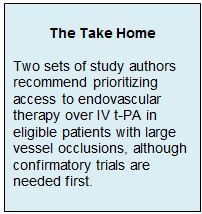Key Points:
- Two studies compare endovascular thrombectomy for anterior circulation stroke with vs without IV thrombolysis
- Thrombolysis adds to cost without improving outcomes

For the first study, Sònia Abilleira, MD, PhD, of the Stroke Program/Agency for Health Quality and Assessment of Catalonia (Barcelona, Spain), and colleagues used their region-wide registry database to identify patients who received endovascular thrombectomy directly (n = 599) or following IV thrombolysis (n = 567) for anterior circulation stroke between January 2011 and October 2015. Patients were stratified into 6 groups in order to balance out baseline characteristics.
Overall, there was no association between use of IV thrombolysis and good outcomes (defined as mRS 0-2), death, or symptomatic bleeding (table 1).
Table 1. Direct Thrombectomy vs IV Thrombolysis + Thrombectomy
|
|
OR (95% CI) |
P Value |
|
mRS 0-2 at 90 Days |
0.97 (0.74-1.27) |
.3022 |
|
Death at 90 Days |
1.07 (0.74-1.54) |
.6131 |
|
Symptomatic Bleeding at 24-36 Hours |
0.56 (0.25-1.27) |
.8592 |
For the second study, Ansaar T. Rai, MD, of West Virginia (Morgantown, WV), and colleagues retrospectively assessed outcomes and hospital costs for 52 patients treated with direct thrombectomy and 38 treated with IV recombinant t-PA followed by thrombectomy at a single center for large vessel occlusions of the anterior circulation.
Both groups of patients were similar with respect to background demographics, stroke severity, and clot distribution. While the mean time to presentation was longer for those who received direct thrombectomy than those who first received IV t-PA, there were no differences between the two groups with respect to rate of successful recanalization, favorable outcome (mRS 0-2), significant hemorrhage (parenchymal hematoma: PH-1 or PH-2), mortality, home discharge, or length of stay (table 2).
Table 2. Effect of IV t-PA Use on Thrombectomy Outcomes
|
|
Without (n = 52) |
With (n = 38) |
P Value |
|
Mean Time to Presentation |
5 hours 19 mins |
1 hour 46 mins |
.0001 |
|
Successful Recanalization |
67% |
81.6% |
.12 |
|
mRS 0-2 |
50% |
58% |
.45 |
|
Significant Hemorrhage |
5.8% |
2.6% |
.46 |
|
Mortality |
25% |
10.5% |
.07 |
|
Home Discharge |
36% |
29% |
.45 |
Despite the similar outcomes, patients whose treatment included IV t-PA had a total mean hospital cost of $40,743 vs $33,810 for direct thrombectomy (P = .02). The direct cost was $23,034 for thrombectomy alone and $28,711 for IV t-PA plus thrombectomy (P = .007).
Additional analyses that included only the 64 patients who presented within 4.5 hours of symptom onset or the 67 patients receiving a stent retriever yielded similar results with respect to both outcomes and costs.
Information to Guide Systems of Stroke Care
Both sets of study authors concluded that these findings have important implications for the development of the most efficient and effective systems of stroke care.
Dr. Abilleira’s team says their results are evidence in favor of the “mother ship” approach, in which eligible patients are directed preferentially to endovascular-capable centers without delay-inducing detours to obtain IV t-PA, as per the “drip and ship” approach. They acknowledge that a randomized controlled trial is needed to confirm this recommendation.
A similar conclusion was reached by the US researchers. “Once [a large vessel occlusion] is identified in a patient with favorable clinical and imaging parameters [for endovascular treatment],” they write, “all resources should be directed at achieving revascularization. In this setting, diverting attention and resources to administering IV rt-PA, which may or may not have an effect on the outcome but does add to the costs, needs to be reexamined.”
Sources:
- Abilleira S, Ribera A, Cardona P, et al. Outcomes after direct thrombectomy or combined intravenous and endovascular treatment are not different. Stroke. 2017;Epub ahead of print.
- Rai AT, Boo SH, Buseman C, et al. Intravenous thrombolysis before endovascular therapy for large vessel strokes can lead to significantly higher hospital costs without improving outcomes. J NeuroIntervent Surg. 2017;Epub ahead of print.
Disclosures:
- Dr. Abilleira reports no relevant conflicts of interest.
- Dr. Rai reports having a consulting agreement with Stryker Neurovascular.